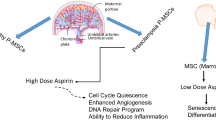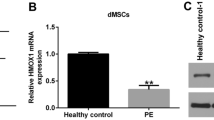Abstract
Objective
To test the effects of human umbilical cord mesenchymal stem cell (HU-MSC) transplantation on reversing preeclampsia (PE) symptoms in a lipopolysaccharide (LPS)-induced rat PE model.
Methods
Human umbilical cord MSCs were detected, isolated, and cultured. Human umbilical cord MSC transplantation was conducted. Expressions of inflammatory cytokines in serum and placental tissue were measured by enzyme-linked immunosorbent assay. Changes in inflammatory cytokines, peroxisome proliferator-activated receptor γ (PPARγ), laminin receptor 1 (LR1), matrix metalloproteinase (MMP) 2, and MMP-9 messenger RNA (mRNA) levels in placental tissue were recorded by quantitative real-time polymerase chain reaction. Immunohistochemistry and Western blotting were performed for PPARγ detection.
Results
The LPS group exhibited increased blood pressure and proteinuria and decreased fetal weight compared to the normal pregnancy (NP) group (all P < .05). The LPS + MSC group presented lowered blood pressure and higher fetal weight than the LPS group (P < .05). The levels of interferon γ, tumor necrosis factor α (TNF-α), interleukin (IL) 1β, IL-6, IL-8, IL-12, and intercellular adhesion molecule 1 (ICAM-1) increased and the levels of IL-4 and IL-10 levels decreased in the LPS group compared to the NP group (all P < .05). Tumor necrosis factor α, IL-6, IL-12, and ICAM-1 levels decreased and IL-10 level increased in the LPS + MSC group compared to the LPS group (all P < .05). The LPS-MSC group showed lower mRNA expressions of TNF-α, IL-6, MMP-2, MMP-9, and ICAM-1 and higher mRNA expressions of IL-10, PPARγ, and LR1 than the LPS group (all P < .05).
Conclusion
In summary, HU-MSC transplantation may be extremely beneficial for PE therapy.
Similar content being viewed by others
References
Too GT, Hill JB. Hypertensive crisis during pregnancy and postpartum period. Semin Perinatol. 2013;37(4):280–287.
Solomon CG, Seely EW. Hypertension in pregnancy. Endocrinol Metab Clin North Am. 2011;40(4):847–863.
Maloney KF, Heller D, Baergen RN. Types of maternal hypertensive disease and their association with pathologic lesions and clinical factors. Fetal Pediatr Pathol. 2012;31(5):319–323.
Arulkumaran N, Lightstone L. Severe pre-eclampsia and hypertensive crises. Best Pract Res Clin Obstet Gynaecol. 2013;27(6):877–884.
Kim JS, Kang EJ, Woo OH, et al. The relationship between preeclampsia, pregnancy-induced hypertension and maternal risk of breast cancer: a meta-analysis. Acta Oncol. 2013;52(8):1643–1648.
Fu B, Tian Z, Wei H. TH17 cells in human recurrent pregnancy loss and pre-eclampsia. Cell Mol Immunol. 2014;11(6):564–570.
Barakonyi A, Miko E, Szereday L, et al. Cell death mechanisms and potentially cytotoxic natural immune cells in human pregnancies complicated by preeclampsia. Reprod Sci. 2014;21(2):155–166.
Tayal D, Goswami B, Patra SK, Tripathi R, Khaneja A. Association of inflammatory cytokines, lipid peroxidation end products and nitric oxide with the clinical severity and fetal outcome in preeclampsia in Indian women. Indian J Clin Biochem. 2014;29(2):139–144.
Ferguson KK, McElrath TF, Chen YH, Mukherjee B, Meeker JD. Longitudinal profiling of inflammatory cytokines and C-reactive protein during uncomplicated and preterm pregnancy. Am J Reprod Immunol. 2014;72(3):326–336.
Jain A, Schneider H, Aliyev E, et al. Hypoxic treatment of human dual placental perfusion induces a preeclampsia-like inflammatory response. Lab Invest. 2014;94(8):873–880.
Geifman-Holtzman O, Xiong Y, Holtzman EJ. Gadd45 stress sensors in preeclampsia. Adv Exp Med Biol. 2013;793:121–129.
Castro-Manrreza ME, Mayani H, Monroy-Garcia A, et al. Human mesenchymal stromal cells from adult and neonatal sources: a comparative in vitro analysis of their immunosuppressive properties against T cells. Stem Cells Dev. 2014;23(11):1217–1232.
Veryasov VN, Savilova AM, Buyanovskaya OA, Chulkina MM, Pavlovich SV, Sukhikh GT. Isolation of mesenchymal stromal cells from extraembryonic tissues and their characteristics. Bull Exp Biol Med. 2014;157(1):119–124.
El Omar R, Beroud J, Stoltz JF, Menu P, Velot E, Decot V. Umbilical cord mesenchymal stem cells: the new gold standard for mesenchymal stem cell-based therapies?. Tissue Eng Part B Rev. 2014;20(5):523–544.
Lu LL, Liu YJ, Yang SG, et al. Isolation and characterization of human umbilical cord mesenchymal stem cells with hematopoiesis-supportive function and other potentials. Haematologica. 2006;91(8):1017–1026.
De Schauwer C, Goossens K, Piepers S, et al. Characterization and profiling of immunomodulatory genes of equine mesenchymal stromal cells from non-invasive sources. Stem Cell Res Ther. 2014;5(1):6.
Karlupia N, Manley NC, Prasad K, Schafer R, Steinberg GK. Intra-arterial transplantation of human umbilical cord blood mononuclear cells is more efficacious and safer compared with umbilical cord mesenchymal stromal cells in a rodent stroke model. Stem Cell Res Ther. 2014;5(2):45.
Joerger-Messerli M, Bruhlmann E, Bessire A, et al. Preeclampsia enhances neuroglial marker expression in umbilical cord Wharton’s jelly-derived mesenchymal stem cells. J Matern Fetal Neonatal Med. 2015;28(4):464–469.
Wang Y, Fan H, Zhao G, et al. miR-16 inhibits the proliferation and angiogenesis-regulating potential of mesenchymal stem cells in severe pre-eclampsia. FEBS J. 2012;279(24):4510–4524.
Liu L, Zhao G, Fan H, et al. Mesenchymal stem cells ameliorate Th1-induced pre-eclampsia-like symptoms in mice via the suppression of TNF-alpha expression. PLoS One. 2014;9(2):e88036.
Nuzzo AM, Giuffrida D, Zenerino C, et al. JunB/Cyclin-D1 imbalance in placental mesenchymal stromal cells derived from preeclamptic pregnancies with fetal-placental compromise. Placenta. 2014;35(7):483–490.
Liu L, Wang Y, Fan H, et al. MicroRNA-181a regulates local immune balance by inhibiting proliferation and immunosuppressive properties of mesenchymal stem cells. Stem Cells. 2012;30(8):1756–1770.
Yan Y, Xu W, Qian H, et al. Mesenchymal stem cells from human umbilical cords ameliorate mouse hepatic injury in vivo. Liver Int. 2009;29(3):356–365.
Qiao CXW, Zhu W, Hu J, Qian H, Yin Q. Human mesenchymal stem cells isolated from the umbilical cord. Cell Biol Int. 2008;32(1):8–15.
Tsai PC, Fu TW, Chen YM, et al. The therapeutic potential of human umbilical mesenchymal stem cells from Wharton’s jelly in the treatment of rat liver fibrosis. Liver Transpl. 2009;15(5):484–495.
Lyall F, Robson SC, Bulmer JN. Spiral artery remodeling and Trophoblast invasion in preeclampsia and fetal growth restriction: relationship to clinical outcome. Hypertension. 2013;62(6):1046–1054.
Laresgoiti-Servitje E. A leading role for the immune system in the pathophysiology of preeclampsia. J Leukoc Biol. 2013;94(2):247–257.
James MT, Hemmelgarn BR, Wiebe N, et al. Glomerular filtration rate, proteinuria, and the incidence and consequences of acute kidney injury: a cohort study. Lancet. 2010;376(9758):2096–2103.
Hamilton S, Oomomian Y, Stephen G, et al. Macrophages infiltrate the human and rat decidua during term and preterm labor: evidence that decidual inflammation precedes labor. Biol Reprod. 2012;86(2):39.
Ryu M, Migliorini A, Miosge N, et al. Plasma leakage through glomerular basement membrane ruptures triggers the proliferation of parietal epithelial cells and crescent formation in noninflammatory glomerular injury. J Pathol. 2012;228(4):482–494.
Rutland CS, Atkinson SD, Mukhopadhyay M, et al. Thrombophilic-type placental pathologies and skeletal growth delay following maternal administration of angiostatin4.5 in mice. Biol Reprod. 2011;84(3):505–513.
Roberts DJ. New hope for prevention of preterm delivery. Am J Pathol. 2013;183(2):330–332.
Zhu HL, Liu YL, Xie XL, Huang JJ, Hou YQ. Effect of L-arginine on intestinal mucosal immune barrier function in weaned pigs after Escherichia coli LPS challenge. Innate Immun. 2013;19(3):242–252.
Monz D, Tutdibi E, Mildau C, et al. Human umbilical cord blood mononuclear cells in a double-hit model of bronchopulmonary dysplasia in neonatal mice. PLoS One. 2013;8(9):e74740.
Vonlaufen A, Phillips PA, Xu Z, et al. Withdrawal of alcohol promotes regression while continued alcohol intake promotes persistence of LPS-induced pancreatic injury in alcohol-fed rats. Gut. 2011;60(2):238–246.
Zhang MJ, Sun JJ, Qian L, et al. Human umbilical mesenchymal stem cells enhance the expression of neurotrophic factors and protect ataxic mice. Brain Res. 2011;1402:122–131.
Zhang Z, Dai M. Effect of paeonol on adhesive function of rat vascular endothelial cells induced by lipopolysaccharide and cocultured with smooth muscle cells. Zhongguo Zhong Yao Za Zhi. 2014;39(6):1058–1063.
Adams WJ, Zhang Y, Cloutier J, et al. Functional vascular endothelium derived from human induced pluripotent stem cells. Stem Cell Reports. 2013;1(2):105–113.
Rautou PE, Leroyer AS, Ramkhelawon B, et al. Microparticles from human atherosclerotic plaques promote endothelial ICAM-1-dependent monocyte adhesion and transendothelial migration. Circ Res. 2011;108(3):335–343.
Munro SK, Mitchell MD, Ponnampalam AP. Histone deacetylase inhibition by trichostatin A mitigates LPS induced TNFalpha and IL-10 production in human placental explants. Placenta. 2013;34(7):567–573.
Brewster JA, Orsi NM, Gopichandran N, Ekbote UV, Cadogan E, Walker JJ. Host inflammatory response profiling in preeclampsia using an in vitro whole blood stimulation model. Hypertens Pregnancy. 2008;27(1):1–16.
Brewster JA, Orsi NM, Gopichandran N, McShane P, Ekbote UV, Walker JJ. Gestational effects on host inflammatory response in normal and pre-eclamptic pregnancies. Eur J Obstet Gynecol Reprod Biol. 2008;140(1):21–26.
Le Blanc K, Ringden O. Immunomodulation by mesenchymal stem cells and clinical experience. J Intern Med. 2007;262(5):509–525.
Lisianyi MI. Mesenchymal stem cells and their immunological properties. Fiziol Zh. 2013;59(3):126–134.
Kode JA, Mukherjee S, Joglekar MV, Hardikar AA. Mesenchymal stem cells: immunobiology and role in immunomodulation and tissue regeneration. Cytotherapy. 2009;11(4):377–391.
Aggarwal S, Pittenger MF. Human mesenchymal stem cells modulate allogeneic immune cell responses. Blood. 2005;105(4):1815–1822.
Rasmusson I, Ringden O, Sundberg B, Le Blanc K. Mesenchymal stem cells inhibit lymphocyte proliferation by mitogens and alloantigens by different mechanisms. Exp Cell Res. 2005;305(1):33–41.
Higdon A, Diers AR, Oh JY, Landar A, Darley-Usmar VM. Cell signalling by reactive lipid species: new concepts and molecular mechanisms. Biochem J. 2012;442(3):453–464.
Waku T, Shiraki T, Oyama T, et al. Structural insight into PPAR-gamma activation through covalent modification with endogenous fatty acids. J Mol Biol. 2009;385(1):188–199.
Rustveld LO, Kelsey SF, Sharma R. Association between maternal infections and preeclampsia: a systematic review of epidemiologic studies. Matern Child Health J. 2008;12(2):223–242.
Kim S, Choi JH, Kim JB, et al. Berberine suppresses TNF-alpha-induced MMP-9 and cell invasion through inhibition of AP-1 activity in MDA-MB-231 human breast cancer cells. Molecules. 2008;13(12):2975–2985.
Adya R, Tan BK, Chen J, Randeva HS. Nuclear factor-kappaB induction by visfatin in human vascular endothelial cells: its role in MMP-2/9 production and activation. Diabetes Care. 2008;31(4):758–760.
Kurdoglu M, Kurdoglu Z, Ozen S, et al. Expression of laminin receptor 1 in human placentas from normal and preeclamptic pregnancies and its relationship with the severity of preeclampsia. J Perinat Med. 2011;39(4):411–416.
Author information
Authors and Affiliations
Corresponding author
Rights and permissions
About this article
Cite this article
Wang, LL., Yu, Y., Guan, HB. et al. Effect of Human Umbilical Cord Mesenchymal Stem Cell Transplantation in a Rat Model of Preeclampsia. Reprod. Sci. 23, 1058–1070 (2016). https://doi.org/10.1177/1933719116630417
Published:
Issue Date:
DOI: https://doi.org/10.1177/1933719116630417




